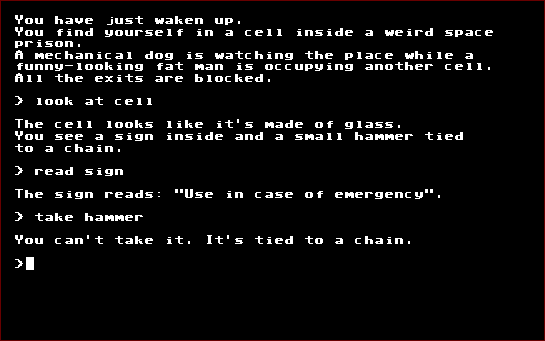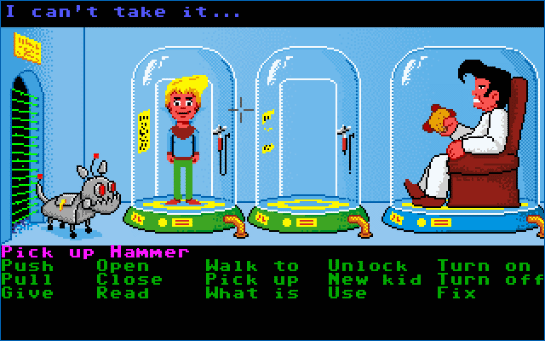You are standing at the end of a road before a small brick building.
Around you is a forest.
A small stream flows out of the building and down a gully.
With these words, the first adventure began.
Its name is "Colossal Cave Adventure" and it was thought and written by William Crowther in 1972 and later enhanced with Don Woods in 1976.
A bit of history
An adventure is usually defined as a game in which the player, with his wits and intelligence, must overcome many obstacle, solving all the puzzles to get to the final "prize". This simple concept is the base of every adventure ever made, even if the interaction methods have evolved and improved with the years.
In the beginning, interaction was text-based: the player had to input by keyboard two words, verb and noun, which were needed to tell the desired action to the program, which would have answered according to the situation described in that moment of the game. Naturally the parser, i.e. the part of the program which analyzed and interpreted the input, was very limited and the program usually responded with sentences like "You can't do that", or "I don't understand".
Because of the limited capacities of the machines in which they were programmed, the first adventures were completely without graphics.
If William Crowther had written The Terrific Menace of the Invaders from Audiogalaxy, it would have looked like this:

"Graphical" adventures
With the advancing of technology (especially in the first half of the 80s), adventure games started to get colour!
Even if the interaction was still text-based, the locations were now illustrated by some more or less detailed graphical screens.
Every adventurer of those times remembers the incredible backgrounds of Magnetic Scrolls' The Pawn.
In some more evolved production (usually by Sierra On Line) it was even possible to interact with the environment, moving the protagonist.
If Rob Steggles had written it then, The Terrific Menace of the Invaders from Audiogalaxy would have looked like this:

The Revolution
People like Roberta Williams (Sierra On Line), Mark Blank and Dave Lebling (Infocom), Rob Steggles and Ken Gordon (Magnetic Scrolls), the Austin brothers (Level 9) and many others had written the best adventure productions of those times.
But in 1987 came the great revolution of the genre. On the videogaming scene a new game appeared: Maniac Mansion, produced by Lucasfilms Games (now Lucasarts), designed and programmed by Ron Gilbert.
The main characteristic was that SCUMM, the scripting language designed ad hoc for the development of adventure games, used and was based on a Point'n Click interface. The player wouldn't have typed the input anymore, it was sufficient a simple click to interact with the game, choosing between icons which represented the default commands and active areas on the screen.
If in 1987 Ron Gilbert had written The Terrific Menace of the Invaders from Audiogalaxy, now it would be known like this:

The Golden Age
The golden age of adventure gaming had begun. Maniac Mansion was followed by many masterpieces which would have become milestones in the history of videogames.
Games like The Secret of Monkey Island, Day of The Tentacle and Full Throttle (just to mention some) brought the adventure gaming genre to a very high level of critic and public appreciation.
People like Tim Schafer, Jonathan Ackley, Dave Grossman, Al Lowe and the aforementioned Gilbert were vulcans of ideas and the productions were many.
Even the gaming mechanics were put in discussion and rethought completely.
For instance, the player couldn't die anymore or get stuck in cul-de-sacs
in the game which would have forced the player to restart from scratch.
The golden age lasted for about ten years, and then the decline started.
In the second half of the 90s, the market of adventure games went into crisis.
There are many reasons for that, but probably the most important is the raise of action games like Doom, which are more liked by the occasional videogamers because of their simplicity and user-friendliness.
Also, the production costs of adventure games had got higher than other games (Mostly due to the localization and voice acting, which had become necessary while they were optional in other game types), so the big firms stopped investing
and the production became more and more rare.
With the new millennium, adventure gaming died almost definetly.
Our contribute to the genre
We tried to develop The Terrific Menace of the Invaders from Audiogalaxy
with passion, basing ourselves on what we learnt from the masterpieces
of the golden age.
Designed with today's knowledge but with our heart looking back to yesterday,
The Terrific Menace of the Invaders from Audiogalaxy looks like this:
Before genereAvventura
From Colossal Cave Adventure
to genereAvventura.
More than 30 years separate the two games and many adventures have been played by millions of people. We don't want to list them all, maybe we wouldn't even be able. But we can make a list of the most significant, from the beginning of the genre to the development of genereAvventura.
- 1972
- Colossal Cave Adventure
- 1976
- Mystery Mansion
- 1978
- Pirate Adventure (Adventure International)
- 1979
- Zork (Infocom)
- 1980
- Mystery House (Sierra)
- The Wizard and the Princess (Sierra)
- 1981
- Zork II: The Wizard of Frobozz (Infocom)
- 1982
- Dark Crystal (Sierra)
- Zork III: The Dungeon Master (Infocom)
- 1983
- Infocom: Planetfall (Infocom)
- Lords of Time (Level 9)
- The Hobbit (Melbourne House)
- The Sorcerer's Castle (Mikro-Gen)
- 1984
- Emerald Isle (Level 9)
- King's Quest: Quest for the Crown (Sierra)
- Lords of Midnight (Beyond Software)
- The Dallas Quest (Datasoft)
- The Hitch-Hiker's Guide to the Galaxy (Infocom)
- The Quest for the Holy Grail (Mastertronic)
- 1985
- Alter Ego (Activision)
- Borrowed Time (Interplay Productions)
- Doomdark's Revenge (Beyond Software)
- Déjà Vu: A nightmare Comes True!! (ICOM Simulations)
- King's Quest II: Romancing the Throne (Sierra)
- The Pawn (Magnetic Scrolls)
- The Vera Cruz Affair (Infogrames)
- 1986
- King's Quest III: To Heir is Human (Sierra)
- Labyrinth (LucasArts)
- Leather Goddesses of Phobos (Infocom)
- Space Quest I: The Sarien Encounter (Sierra)
- Tass Times in Tonetown (Interplay Productions)
- Uninvited (ICOM Simulations)
- 1987
- Bureaucracy (Infocom)
- Gnome Ranger (Level 9)
- Jinxter (Magnetic Scrolls)
- Knight Orc (Level 9)
- Leisure Suit Larry I: In the Land of the Lounge Lizards (Sierra)
- Maniac Mansion (LucasArts)
- Police Quest: In Pursuit of the Death Angel (Sierra)
- Shadowgate (ICOM Simulations)
- Shadows of Mordor (Melbourne House)
- Space Quest II: Vohaul's Revenge (Sierra)
- The Guild of Thieves (Magnetic Scrolls)
- 1988
- Corruption (Magnetic Scrolls)
- Déjà Vu II: Lost in Las Vegas (ICOM Simulations)
- King's Quest IV: The Perils of Rosella (1988)
- Leisure Suit Larry Goes Looking for Love (Sierra)
- Neuromancer (Interplay Productions)
- Police Quest II: The Vengeance (Sierra)
- Zak McKracken and the Alien Mindbenders (LucasArts)
- 1989
- Arthur: The Quest for Excalibur (Infocom)
- Indiana Jones and the Last Crusade (LucasArts)
- Leisure Suit Larry III: Passionate Patti in Pursuit of the Pulsating Pectorals (Sierra)
- Mean Streets (Access Software)
- Myth (Magnetic Scrolls)
- Space Quest III: The Pirates of Pestulon (Sierra)
- The Colonel's Bequest (Sierra)
- The Quest for Glory I: So You Want to be a Hero (Sierra)
- 1990
- Elvira, Mistress of the Dark (Horrorsoft)
- King's Quest V: Absence Makes the Heart go Yonder! (Sierra)
- King's Quest V: Absence Makes the Heart go Yonder! (Sierra)
- Loom (LucasArts)
- Police Quest III: The Kindred (Sierra)
- The Quest for Glory II: Trial by Fire (Sierra)
- The Secret of Monkey Island (LucasArts)
- Wonderland (Magnetic Scrolls)
- 1991
- Castle of Dr. Brain (Sierra)
- Cruise for a Corpse (Delphine Software)
- Gobliiins (Coktel Vision)
- Laura Bow II: Dagger of Amon Ra (Sierra)
- Leisure Suit Larry V: Passionate Patti Does a Little Undercover Work (Sierra)
- Lord of the Rings (Interplay Productions)
- Monkey Island 2: LeChuck's Revenge (LucasArts)
- Space Quest IV: Roger Wilco and the Time Rippers (Sierra)
- 1992
- Darkseed (Cyberdreams)
- Gobliins 2: The Prince Buffoon (Coktel Vision)
- Indiana Jones and the Fate of Atlantis (LucasArts)
- King's Quest VI: Heir Today, Gone Tomorrow (Sierra)
- Lure of the Temptress (Revolution)
- Nippon Safes, Inc. (Dynabyte)
- The Legend of Kyrandia (Westwood Studios)
- The Quest for Glory III: Wages of War (Sierra)
- 1993
- 7Th Guest (Trilobyte)
- Alone in the Dark (Infogrames)
- Betrayal at Krondor (Dynamix)
- Day of the Tentacle (LucasArts)
- Gabriel Knight: The Sins of the Fathers (Sierra)
- Goblins 3 (Coktel Vision)
- Leisure Suit Larry VI: Shape Up or Slip Out (Sierra)
- Myst (Cyan)
- Police Quest IV: Open Season (Sierra)
- Psygnosis: Innocent Until Caught (Psygnosis)
- Return to Zork (Activision)
- Sam & Max: Hit the Road (LucasArts)
- Simon the Sorcerer (Adventure Soft)
- Space Quest V: Roger Wilco in the Next Mutation (Sierra)
- The Legend of Kyrandia 2: The Hand of Fate (Westwood Studios)
- Ween The Prophecy (Coktel Vision)
- 1994
- Alone in the Dark II: Hell's Kitchen (Infogrames)
- Beneath a Steel Sky (Revolution)
- Full Throttle (LucasArts)
- King's Quest VII: The Princeless Bride (Sierra)
- Little Big Adventure (Adeline)
- Lost in Time (Coktel Vision)
- Quest for Glory IV: Shadows of Darkness (Sierra)
- Shadow of the Comet (Infogrames)
- The Legend of Kyrandia 3: Malcolm's Revenge (Westwood Studios)
- Universe (Core Design)
- 1995
- 11th Hour (Trilobyte)
- Alone in the Dark III: Hell's Kitchen (Infogrames)
- Bureau 13 (Take 2)
- Darkseed II (Cyberdreams)
- Discworld (Psygnosis)
- Dream Web (Empire)
- Flight of the Amazon Queen (Interactive Binary)
- Gabriel Knight: The Beast Within (Sierra)
- Guilty: Innocent Until Caught 2 (Psygnosis)
- Phantasmagoria (Sierra)
- Police Quest: S. W. A. T. (Sierra)
- Shannara (Legend)
- Simon the Sorcerer 2: The Lion, the Wizard and the Wardrobe (Adventure Soft)
- Space Quest VI: The Spinal Frontier (Sierra)
- The Big Red Adventure (Dynabyte)
- The Dig (LucasArts)
- Torin's Passage (Sierra)
- Under a Killing Moon (Access Software)
- 1996
- Broken Sword: The Shadow of the Templars (Revolution)
- Leisure Suit Larry 7 Love For Sail (Sierra)
- Lighthouse (Sierra)
- Phantasmagoria II: A Puzzle of Flesh (Sierra)
- Ripper (Take 2)
- The Pandora Directive (Access Software)
- Toonstruck (Burst Studios)
- 1997
- Blade Runner (Westwood Studios)
- Broken Sword 2: The Smoking Mirror (Revolution)
- City of Lost Children (Psygnosis)
- Dark Earth (MicroProse)
- Discworld 2 (Psygnosis)
- Fable (Telstar)
- Little Big Adventure 2 (Adeline)
- Riven (Cyan)
- The Curse of Monkey Island (LucasArts)
- The Neverhood (DreamWorks)
- Ufo's (Artech Studios)
- Versailles (Cryo Interactive)
- 1998
- Black Dahlia (Take 2)
- Grim Fandango (LucasArts)
- King's Quest VIII: Mask of Eternity (Sierra)
- Overseer (Access Software)
- Police Quest: S. W. A. T. 2 (Sierra)
- Quest for Glory V: Dragon Fire (Sierra)
- 1999
- Faust (Cryo Interactive)
- Gabriel Knight: Blood of the Sacred, Blood of the Damned (Sierra)
- Nocturne (Terminal Reality)
- 2000
- Escape from Monkey Island (LucasArts)
- The Longest Journey (Funcom)
- 2001
- Runaway: A Road Adventure (Pendulo Studios)
- Stupid Invaders (Xilam)
- 2002
- Noctropolis (Electronic Arts)
- Syberia (Microids)
- Tony Tough and the Night of Roasted Moths (Prograph)